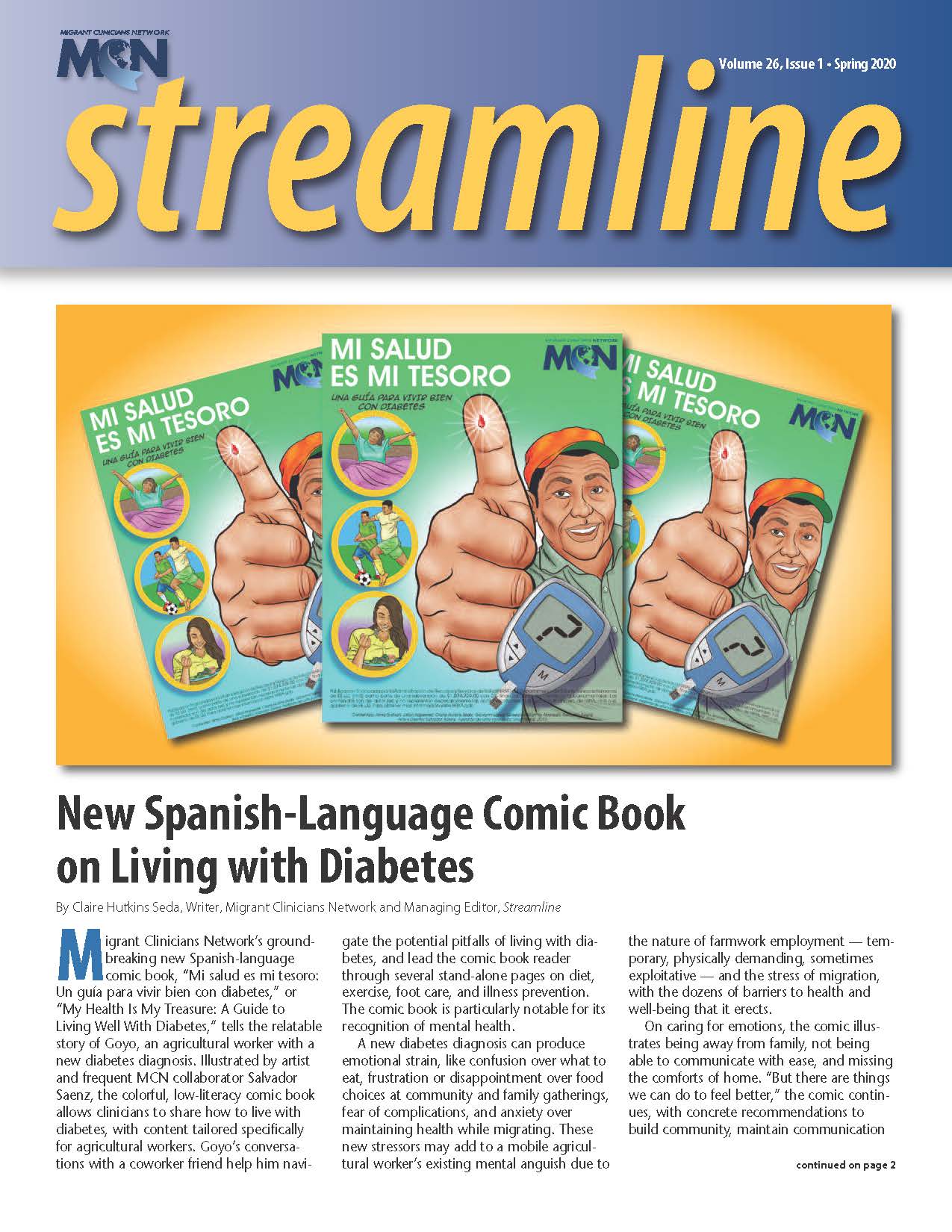Salvador Saenz, the well-known illustrator and public health educator behind many of MCN’s popular comic books including our new diabetes comic book, recently completed yet another colorful resource on diabetes, this time with Farmworker Justice. In the four-page, full-color “Life of the Party: Making Healthy Choices with Diabetes,” the characters learn to read nutrition labels and what foods to eat freely before heading to a party. The resource is available in Spanish, English, and Haitian Creole:
https://www.farmworkerjustice.org/resources/health/health-awareness-prevention/diabetes/life-party-making-healthy-choices-diabetes
Several years ago, Saenz partnered with the University of Texas, Health Science Center in Houston and the School of Public Health, El Paso Regional Campus, to develop a series of comic books on cholesterol and hypertension in English and Spanish. Access all of the resources at: https://www.migrantclinician.org/toolsource/746/hypertension/index.html.
In “How to Control Your Hypertension,” the reader meets Raymundo and his family, as they navigate Raymundo’s new hypertension diagnosis. The comic book covers medication adherence, side effects, the clinician-patient relationship, and methods of controlling stress, through the low-literacy format. An activity on the “garden of virtues” encourages the reader to seek out virtues like hope, perseverance, gratitude, and self-control to maintain a healthy lifestyle. The piece, available in English and Spanish, ends with a page to track blood pressure levels and to write out health goals. The accompanying guide for community health workers and promotores includes activities around hypertension and brochures to help patients with hypertension to think through questions to ask the doctor.
A second comic book, “How to Control Your Fat and Cholesterol,” continues to follow Raymundo’s family, this time focusing on his wife and son, who discover that they have high cholesterol. The comic book details in pictures what high cholesterol does to the body and provides practical advice on how to reduce cholesterol numbers.
Many other groups have created comic books for outreach with their own approaches and illustrators. The School of Pharmacy at the University of Southern California focuses on an entertaining approach to hypertension in its comic, “Lucia’s Llama Drama,” in addition to other comic books addressing diabetes, childhood obesity, breast cancer, immunizations, and more, available in English and Spanish: https://pharmacyschool.usc.edu/fotonovelas/
The Western Center for Agricultural Health and Safety at the University of California, Davis, has a prediabetes comic book in English and Spanish called, “The Five Healthy Steps for the Prevention of Diabetes”: https://aghealth.ucdavis.edu/educational-materials
Health Network and PRAPARE
In 2016, just as PRAPARE was set to launch, Migrant Clinicians Network was beginning to develop its new database to better serve patients enrolled in Health Network, MCN’s bridge case management program. Over the course of the following year, MCN configured the new database to allow for the integration of PRAPARE data, in which one health center’s PRAPARE data can be transferred to the next health center, as a mobile patient moves.
“When we started thinking about that data and [Health Network] case management work, so much of case management isn’t just ‘are you taking your medication every day?’ It’s more about, ‘How can I help you access care and manage your health in general?’” explained Anna Gard, RN, who assisted MCN in the development of the new database. “One piece of this is: ‘Let me help you find a health center.’ But the larger pieces around effective case management are, ‘How are you going to get there? Is there public transportation? How are you going to pick up your medications if you live in a hostile community and you’re afraid of leaving the house?’ PRAPARE gives a structured format to capture [these] data, in a form that’s been tested and validated.”
As more health centers provide case management and chronic care management to address the social determinants of health, Gard noted, integration of the PRAPARE data with Health Network, a virtual case management, seemed to make sense. Now, the Health Network team is working to fit PRAPARE into their own workflow.
Saul Delgado, Health Network Data Specialist, who has been integral in building and launching Health Network’s new case management system, notes that asking such personal questions over the phone, when a patient doesn’t have transferrable PRAPARE data from a previous health center, can be challenging. “When we call, the patient doesn’t know you. They’re very scared to answer these kinds of personal questions, whereas when you go the clinic, you at least see the nurse or case worker face-to-face,” he explained. But he recognizes the utility of the data, and has developed the PRAPARE data screens within the database to be easily accessed from the main patient information screen. With drop-down menus, Health Network Associates can populate the information they hear from patients, like how many people live with them in their household, or if they’re worried about losing their home. The information, either attained from a previous health center or inputted by a Health Network Associate, will be transferred when the mobile patient gets to his or her next destination, just as the basic medical records do.
“Health centers are doing more to integrate social and behavioral determinants of health, and we’re recognizing that all of those things have to be integrated with care management. So we’re on the forefront,” Gard concluded.

Read this article in the Spring 2020 issue of Streamline here!
Sign up for our eNewsletter to receive bimonthly news from MCN, including announcements of the next Streamline.
